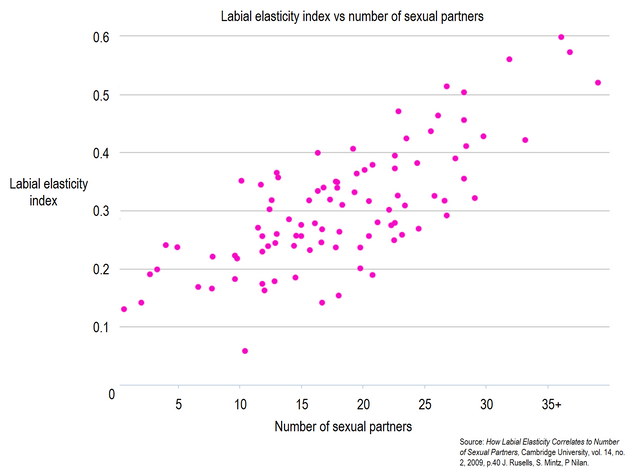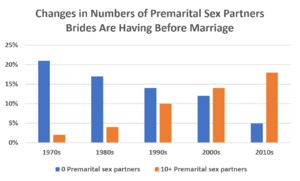Slut
A "slut" is (a slur for) a promiscuous woman, which may or may not overlap with whoredom. In the popular imagination, sluts are typically characterized as being particularly hypergamous, heartbreakers, dangerous to liaise with, sneaky, psychopathic/borderline, and bisexual.[1]
In terms of the external characteristics that denote sluts, several lines of evidence suggest they tend to engage in body modification,[2] tattooing, and the wearing of "choker" necklaces, likely to signal their sluttery to receptive males (despite their frequent denial of this).[3][4]
Among the behavioral traits of sluts, it appears they tend to be disinterested in long-term bonding, with sluts typically seeking either rapid access to a man's resources or prioritizing their sexual pleasure. This lack of a general disposition towards relational fidelity may be revealed by sluts behaving in such ways as being overly flirty with men and wearing sexually provocative clothing, things that provoke their man's mate guarding and restraint, and being overall a brat.
However, it is vital to note that many sluts disingenuously pretend to be obedient virgins, especially when they are situationally pursuing a longer-term mating strategy to receive long-term provision from a man. This deception on behalf of the slut is typically required because men tend to ascribe importance to traits that indicate that they will be less likely to be cuckolded in the context of sexual relationships that require substantial emotional, temporal, and financial investment on their part. As such, men often engage in slut-shaming, partly to ensure paternity, whereas women engage in it as a means of intrasexual competition as men and others care about it. A tendency towards characterizing a more desirable female rival as a "slut" may also suit certain women's conceited nature. In the case of mothers, impulses to restrict other women's promiscuity may be explicable due to these actions resulting in their sons running less risk of falling prey to cuckoldry, thus increasing the women's own reproductive success in the long term.[5]
In sum, sluts pursue a fast life history strategy, focused on the immediate extraction of resources, sexual pleasure, and possibly physical protection from men, as opposed to seeking long-term attachments,[6] i.e., blatant whoring and sexual promiscuity. These dispositional tendencies may lead to these women pursuing a dual mating strategy or any socially parasitic strategy that ultimately results in all but the father providing for the offspring, i.e., the woman's family, the group, or the state.
A sexual conflict[edit | edit source]
Women inciting male competition[edit | edit source]
There is a good principle which created order, light, and man, and an evil principle which created chaos, darkness, and woman.
Women benefit from the chaos of testing and selecting among many men by inciting competition among men for their affections to eventually get chosen by the strongest and most determined male possible. Men, as a group, benefit from order, from reining in their women's whoredom, i.e., via mate guarding her from contending males she arouses interest from, and also to ensure the offspring he invests in is his own. The man also does not want to lose face owing to being cucked or having his mate poached by some other man.
Reshuffling the cards is less costly for women as there is an oversupply of men. Their coyness may extend even to romantic relationships, with steady investment in terms of resources, time and attention on behalf of men required for these relationships to continue. Most men seem happy as long as they get sex, a basic level of affection, and relational fidelity from their women. Thus, for men, the dissolution of a relationship more often means restarting from zero, amassing and investing his resources anew, perhaps explaining the higher suicide rate among young male widowers compared to widows.[7] It may also explain why unmarried and childless women seem less resistant to alien rule than men.[8]
Female sexual reluctance[edit | edit source]
Another example of sexual conflict is the apparent desire (conscious or not) on behalf of many females to require coercion from their male partners, in extreme cases even rape, before sex can occur. In many animal species, the female typically exhibits sexual reluctance when approached by a male, often requiring violent coercion on the male part for the copulation to occur, further testing the male. Some have observed this sort of animalistic courtship behavior applies to humans, and indeed, it does seem that sexual coercion is by no means an uncommon aspect of human mating behavior.[9][10]
This behavior on behalf of women seems primitive and incompatible with modern civilization. It sexually rewards anti-social and non-altruistic males and directly disincentivizes the pursuit of more civilized courtship behaviors among men and creates highly perverse incentives. As such, it is common in the more evo-psych aware quarters of the manosphere to assert that women may have been subject to less selection pressure, essentially leaving their minds (as it pertains to mating), in the stone-age or even earlier periods of human development. Sluts may be particularly prone to desire to test their man's physical dominance and desire for them in such a matter. There is some evidence that more women may exhibit a stronger preference for overtly violent, anti-social, and insensitive men in the context of short-term relationships,[11] and such preferences would leave women that heavily pursue such relationships (sluts) at higher risk of being sexually assaulted if they were initialized.
Slut hate[edit | edit source]
Men often hate sluts as they tease them with what they cannot have, causing envy, resentment, unwanted erections, distracting them, and so on.
Another likely predictor of slut hate, ironically, among men is a stronger behavioral disposition towards a casual dating strategy on behalf of the men, as the esteemed English playwright William Shakespeare noted and eloquently stated in his "King Lear":
"Thou rascal beadle, hold thy bloody hand!
Why dost thou lash that whore? Strip thy own back. Thou hotly lusts to use her in that kind
For which thou whipp'st her."[12]
It seems that higher sociosexuality (a measure of promiscuous behavior and attitudes) is the main predictor of male over the typical over perception on behalf of men of the sexual availability of women, and not the conventional male desire to maximize sexual opportunities as is often claimed.[13] It seems that there is a fundamental empathy gap where highly promiscuous and libidinous men often do not understand that women are generally much less sexually interested in the bulk of men than men are in women, causing over perceptions of sexual interest on behalf of men and thus heightened sexual frustration and rage. Women that engage in overt sexual displays make the situation worse as they promise swift sexual access (in the eyes of these concupiscent men in particular) but generally do not render it on to the average male. Taken together with evidence that suggests that male sexism is associated with higher levels of sexual success[14], we can perhaps discern two distinct kinds of men who have a heightened aversion towards sluts, while still being intensely attentive towards these women's provocative antics.
On one hand, sexually successful men who exhibit high levels of sexual entitlement, a distant attachment style, a primarily instrumental view of sexual relationships,[15]and low levels of positive affect in relationships in general, i.e., general traits associated with a fast-life history strategy (and perhaps also a direct consequence of heightened sexual success, as they may become jaded by dealing with the presumably capricious antics of the sluts they partner with). On the other hand, the undesirable men who hate sluts may often possess similar constellations of traits. However, as these men may lack the critical behavioral, dispositional, social, and physical characteristics required for sexual success, their loathing for sluts would be expected to be further inflamed.
Since men do not desire sluts as long-term partners, women can increase their sexual chances by insinuating and gossiping that other women, particularly sexual rivals, are sluts.[16][17] Men desire sluts for short-term encounters with zero investment to simply spread their seed but generally dislike marrying and investing in slutty women as they might prove to be particularly difficult to contain.
Sluts are loose[edit | edit source]
Most women referred to as "sluts" reserve the bulk of their sexual favors for attractive men. These "common sluts" range from 4-7 in attractiveness and take turns getting fucked by multiple 8+/10 males. By doing this they boost hypergamy, leaving their looksmatches incel. Once such a variety of penetration has loosened up a woman's vagina, she sometimes begins needing two partners at the same time to feel anything, thereby becoming a double-stuffer.
The theoretical slut[edit | edit source]
Sex-positive feminists, and even some incels, argue that the sexual revolution and the resulting increased social acceptability of slutty behavior is generally good for men as women's promiscuity increased by social engineering will "trickle down" to the "lower strata" of men. The problem with this argument is that this theoretical type of woman is unlikely to exist because women are choosy and hypergamous maters. Even sluts are not entirely indiscriminate in the men they have chosen to have sex with, however this desirability is defined.[18]
Slutpride[edit | edit source]
In the mid-2010s, many women took it to the streets to make it well known they are promiscuous, seeking to "reclaim" the word and disassociate it from any negative connotations. These confessed sluts asserted that the primary raison d'être for these demonstrations was to rebuke a "patriarchal rape culture," particularly as it pertains to so-called "rape myths" that associate greater female promiscuity with sexual victimization and society's greater acceptance of this when it is directed towards sluts.[19] Many incels took offense at this mass display of anti-social, morally degenerate behavior on behalf of these slut-marchers as it was occurring amid a sex recession and the acceleration of inceldom. Their attitudes were something to the effect of: "These sluts are protesting about being shamed for being promiscuous with wagecucks and chads, so who cares about their dumb parades?"
Causes of sluttishness[edit | edit source]
Signaling theory[edit | edit source]
Arguably the leading cause of sluttishness is the slut's desire to arouse attention from high-status or otherwise desirable men. As women's mating strategy is primarily passive (at least in the initial stages of courtship), women often seek to arouse men or otherwise signal desirable characteristics openly to entice men to approach them and initiate the courtship process. This need to engage in displays of overt displays of sexual availability (tacit or implicit) may also explain women's seeming greater propensity to engage in attention-seeking behavior and the tremendous hedonic pleasure they seem to receive when their conspicuous sexual displays are rewarded by male attention.
This female need to seek validation from men may also explain perceptions of greater female sluttishness. As men are typically hornier than women, more drawn towards short-term mating in general,[20] and are punished less for being promiscuous (cross-culturally, generally actually attaining greater peer-status in proportion to their level of promiscuity to a degree)[21] it would appear that the most effective (at least in the short-term) way for women to gain men's attention is to engage in slutty behavior, for example via wearing tight, revealing clothing, engaging in various forms of body modification, adopting sexually provocative poses, and so forth.
Theoretically, the major restraints against the widespread adoption of this attention-whoring strategy would be the social opprobrium that sluts accrue (typically directed at sluts from other women), the societal maintenance of strong religious or cultural taboos (indeed, historically often aimed mainly, or even solely, in the direction of restricting female sexuality, apart from the exception of Christianity and Islam to a lesser degree), or the need to maintain one's chastity to be able to attract a particularly desirable and provident male partner.
In societies where these restraints are weak, and women do not need to rely on male provision for their survival, it would seem that women are thus increasingly incentivized to sexually objectify themselves in an increasingly blatant manner to lure men and obtain the sexual and financial benefits of this. This incentivization to behave in a slutty matter could be explicable by signaling theory, with women's provocative behavior functioning as either an honest or dishonest signal of imminent sexual access on these women's behalf in the eyes of men who observe and respond to these signals. There is evidence that suggests men are quite good at discerning which women that are are less sexually restricted, as these women are more often publically approached by strangers seeking sexual encounters (thus, these displays do function as an honest signal of greater sexual receptivity on behalf of the woman to some extent).[22]
An example of how this played out in modern society would be to take the example of the promiscuous women that have always been prominent throughout history, prostitutes. These women naturally sexualize themselves heavily to draw in male customers. Post-sexual revolution, it is common to see non-prostitutes increasingly adopt the garb, behavioral affections, and in some cases, the mating strategy of prostitutes. As the sexual revolution was essentially a substantial reduction of the historically typical expectation of extra-marital sexual restraint on behalf of the mass of the fairer sex, it is likely that this removal swiftly caused or heightened a certain 'slut-envy' on behalf of less promiscuous women. With religious beliefs declining and men keen to maximize their sexual success, the only restraint on female sexual signaling was increasing "slut-shaming", mainly perpetrated by other women.[23] This heightened female intrasexual competition may have led to a cascade of slutty behavior forming from a feedback loop wherein women were/are increasingly competing with each other via dressing and behaving in sexually provocative ways to extract maximum attention from men.
As sluts are more prone to being on the receiving end of averse female intrasexual competition-related tactics, such as bullying and gossip, and social perceptions of sluttishness are to a degree relative, this implies that sluts or pseudo-sluts have to strike a balance where they enhance their sexy behavior and appearance as much as possible while still not being perceived as overly slutty compared to their peers. This conflicting need to signal sexuality while still maintaining a modicum of decorum explains why sluts absurdly declaim they are only "dressing for themselves" and the like when they are on the receiving end of slut-shaming.
Where economical, biological, or social incentives gear women towards a fast life history strategy, one would expect this process of sluttification to be even more pronounced, with less negative feedback in terms of social reinforcement of chastity norms being in place in such milieus to halt the remorseless progression of this slut signaling by women.
Economic incentives[edit | edit source]
Increasing female economic independence from men (at least in terms of being directly dependent on male provision) due to modern welfare states, modernity in general, technological advances, and the widespread inclusion of women in the workforce has also likely contributed to this behavior. When women do not have a strong need to maintain a reputation for virtue to be seen as a viable marriage prospect for men, they are therefore more free to behave in a promiscuous manner. Men's desire for chaste women thus effectively degrades, as it becomes increasingly absurd and unreasonable for them to demand completely chaste women in a society where premarital sex is normalized outside of strict religious subcultures.
Together with economic and sociological factors that increase women's financial status vis-a-vis men, this may lead to demotivation on behalf of men who are not desirable enough to take part in casual sex, as they do not see the worth of putting in the effort to be considered "marriagable" by women that have a clear history of relative promiscuity. Thus, men's perception of increasing sluttiness on behalf of women may be one reason why a large number of marriageable age men become NEETs, i.e., drop out of the workforce and often society entirely.
Economic incentives can drive parents to sexualize their daughters to attract a well-earning man, especially in a climate of hyper-sexualized pop culture and in times of increasing economic uncertainty and inequality. Indeed, women, in general, are found to be more sexualized on social media under such conditions.[24]
Other causes[edit | edit source]
Another cause of slutty behavior may be childhood sexual abuse (CSA), which increases chances of engaging in "risky sexual behavior" by factor 3.[25] However, causality is unclear in this case, as many children are abused by those genetically related to them.[26] Thus, it is challenging to disentangle genetic influences that may both result in promiscuity in the child and the greater propensity to commit acts of molestation on behalf of kin caregivers who have greater access to the victim.
There is evidence that early CSA may accelerate women's life history speed on a broad phenotypic level. In support of this hypothesis, Vigil et al. (2005), controlling for several socioeconomic factors (and lack of paternal investment, presumably a potent indicator of the father's life history strategy), did find that CSA was associated with several indices of a faster life history strategy, including earlier age at first menarche, younger age at first sex, and increased reported desire to have a child earlier on behalf of abused girls.[27]
There are also many genetic factors that result in a predisposition towards slutty behavior in women, explaining 50% of the variance in sociosexuality (tendency to engage in and a positive attitude towards casual sex) in one study. [28] Thus, a restriction of harsh social norms that restrict conspicuous slutty behavior among women will naturally result in a subculture of ostentatious sluts rapidly forming in a society once they were freed of these restrictions, as it were.
Several threads of evidence also suggest that increased phenotypical masculinity in women is associated with promiscuity, perhaps being indicative of masculinized women tending to adopt a more male-typical sexual strategy. Firstly, it has been proposed that greater early exposure to androgens serves to accelerate life history speed, both in animals and in humans, and thus more masculine women would be expected to be more r-selected.[29]
Secondly, evidence directly suggests that higher phenotypical androgenicity in women is associated with greater sociosexuality in women. For instance, Clark (2004) found that women that exhibited a more male-typical cognitive profile (superior spatial rotation ability) and a lower 2D:4D ratio (a purported marker of higher prenatal testosterone exposure) were more sociosexuality unrestricted.[30] Other research indicates that women who engage in nonheterosexual behavior are generally more physically masculinized, more promiscuous, and higher in several fast life-history traits, with this faster life history strategy on behalf of said women proposed to be mediated by the actions of masculinizing alleles.[31] Further, a cross-cultural study by Bártová et al. (2020) found that women who exhibited a more masculine gender identity were more sociosexually unrestricted. However, the opposite effect was found for men (i.e., more feminine men were more socially unrestricted), leading the authors to speculate that androgyny, in general, may predict more sexually permissive attitudes and behaviors and not masculinity per se.
Some researchers, however, have disputed the purported link between fast life-history strategies and masculine traits in women. They argue that sex differences in promiscuity (males are generally more promiscuous, or at least intend to be so) are reflective of specialized adaptions to increase mating effort in males owing to their lower parental investment and are not truly indicative of broad sex differences in life-history traits. They further propose that research into such things as the broader autism phenotype suggest that there may be masculine individuals who pursue slower life-history strategies, and thus any claims of physical masculinization being robustly correlated with a faster life history strategy in women need to be strictly qualified.[32]
Sexual revolution[edit | edit source]
Probably the primary factor that has increased slutty behavior on behalf of women was the sexual revolution that seemingly began during the Second World War (with rates of single mothers rapidly growing during this period along with other signs of increasing moral profligacy)[33], and that reached its central inflection point in the 1960s, coinciding with the advent of the 60s counter-culture associated with hippies, the new-left, and various other subcultures.[34]
This sexual revolution can be essentially characterized as the period when traditional social mores that served to inhibit sexual promiscuous behavior and the open display of this behavior (more so among women than men) eroded and then nearly collapsed, with premarital chastity among women going from being the norm to becoming relatively uncommon (and thus likely reflective of a restrictive attitude towards sexuality, i.e., largely voluntary).[35]
The causes of the sexual revolution are far too complex to delve into at length here. It will suffice to state that the primary explanations for it are: the development of the contraceptive pill (leading to more reliable contraception in lieu of using condoms, which were already widely available at the time, plus granting women greater control over reproduction), societal trends that increased the economic and social status of women, chastity norms being violated during the Second World War (driven by a male sexual preference for quick sex and men's greater bargaining power due to the surfeit of women vis à vis men owing to widespread slaughter of men during that conflict) setting a precedent for sexual looseness,[36] an increase in genetic mutations leading to a collapse in social structures that served to limit individualism and promote conformance to group norms, among other things.
Increasing female promiscuity subsequent to the sexual revolution can be shown by there being a strong secular trend towards increasing female premarital promiscuity from the second half of the 20th century onwards in Western countries. In the United States, in particular, 18% of women in the U.S had ten or more partners before marriage in the 2010s vs. 2% of women in the 1970s, based on the NSFG (National Survey of Family Growth) data.[37] In more modern times, the deferred age of first marriage also likely contributes to promiscuity among certain women, as it is perhaps unreasonable to expect the majority of them to remain utterly chaste until their late 20s or even 30s (in many countries).
Behavior of sluts[edit | edit source]
Promiscuous women often exhibit borderline personality disorder and psychopathy,[38] and appear to be more impulsive and have shorter time horizons (less likely to plan for the future).[39] They also seem to be more likely to be "night-owls", with eveningness being associated with promiscuity among women.[40] Cluster B women generally have a much higher number of lifetime sexual partners.[41] That all of these aforementioned traits seem to be linked to less sexual restraint in women is not surprising, as they all have been proposed to converge on a greater life-history factor.
Many left-wing feminist women seem to show signs of highly slutty behavior, possibly partly due to an overlap between this political disposition and borderline personality traits and mental instability in general.[42]
Somewhat to the contrary of this association with slutdom and highly unpleasant female behavior, there is also some evidence that there is a curvilinear association with interpersonal warmth and sluttishness, i.e., sluts may be more likely to be both highly warm or highly cold and disagreeable.[43]
Are all modern Western women sluts?[edit | edit source]
Contrary to the general impression within the manosphere, there is not much evidence of female promiscuity having sharply increased in recent decades, with female promiscuity seeming to have stabilized in the 1980s in most Western countries. In Germany, France, and the In the U.S., sexlessness has increased for women in the recent decades, likely due to weaker monogamy norms, later marriage, feminism shifting women's focus from reproduction to work, increasing social atomization, low birth rates and the resulting 'helicopter' parenting.
For the U.S., studies are indicating a shift from an average of 2 lifetime sexual partners for women and 6 for men in 1970 to about 4 partners for women and 6 for men in 2006,[44][45] however, the first study reports medians and the second means, and this change can also be possibly explained by women having become more honest about their sexual lives.
Nonetheless, a minority of women do seem to have "lots of sex" and can get it substantially more easily than men,[46] and among the minority who engages in dating, in a 2018 U.S. study, among people who live an active, uncommitted dating life, heterosexual men met an average of 2.4 partners for dating or sex in the past 12 months whereas that figure was 5.1 partners for women.[46] This figure may be explicable by women's ruthless drive to exploit their generally higher mating market value by maximizing the number of men who are competing for their affections, in effect leading men on and only choosing a minuscule number of them to have sex with, as there does not seem to be evidence of the general population of contemporary women being wildly promiscuous in comparison to men. However, this seems to vary by age cohort. A minority of men also has plenty of sex, perhaps more than ever before.[47] So, even though people, in general, have overall less sex, and there is possible a larger amount of people who have very little sex, a "sexual elite" appears to have much more.
Perceptions of increasing female promiscuity may be driven by a substantial minority of sluts engaging in increasingly shameless sexual behavior and disseminating proof of these acts online for mass consumption. The rise of social media, increasing economic stratification (and due to this, increasing female intrasexual competition for the few wealthy/high-status males left)[48] and increasingly liberal attitudes towards sex has also likely resulted in women being franker in advertising their sexual assets to men through increasingly slutty forms of dress.
One could argue that the (historically unusual) large amount of young single women play a role in this, with these women not having a male partner to induce them to dress more modestly and with these women also being prone to dressing in a revealing manner to advertise themselves sexually to desirable male partners, also increasing intrasexual competition among both sexes.
There are countries where female promiscuity does seem to be extreme in terms of sexual promiscuity. For example, a 2000 survey conducted by the condom manufacturer Durex found that New Zealand women reported an average of 20.4 sexual partners, much higher than the New Zealand male average of 16.8.[49] New Zealand was the only country in the survey where women confessed a higher average sexual partner count than men. So there do seem to be substantial country-level variations in female promiscuity and sluttiness, even among Western countries, and arguably also variation between different subcultures. (However, it should be noted that the survey by Durex has been criticized for undersampling, a criticism that reveals a lack of statistical nous as even relatively small surveys can be valid as long as the sample is representative of the general population).[50]
Aversion towards sluts[edit | edit source]
Male aversion towards sluts[edit | edit source]
There is some evidence that a preference for chaste mates may be partially hardwired in men, owing to their evolutionary history. A promiscuous woman is a poor investment for a long-term relationship, due to the greater risk she may cuckold the man,[51] or indeed may already have dependent offspring that compete with his potential offspring for resources. Promiscuous women also pose a much higher STD risk.[52] Research has shown that this preference is so ingrained in men that they even prefer less promiscuous prostitutes (later age of first sex and fewer years spent in the profession), rewarding them with higher pay for their services.[53][54]
Men often rate chastity and especially marital or relational fidelity as one of the most valued traits in a female marriage prospect, though the aversion towards women with a high premarital partner count is lower in more sexually permissive cultures, such as Sweden.[55] This may be more due to simple male resignation to the widespread mainstreaming of slutdom than indicative of any underlying male shift in attitudes on this issue.
On the contrary to the male preference for chastity when it comes to long-term partners, there is evidence that female promiscuity is moderately desired by men in a female partner when they are seeking casual sexual encounters, due to perceptions of sluts being 'easier' and 'less clingy' (easier to pump and dump).[55] This shift in preference could be seen as evidence for the psychoanalyst Sigmund Freud's (in)famous assertion (stolen from Otto Weininger) of the existence of a "Madonna/whore" complex on behalf of men, at least in the sense of men exhibiting their dual-mating strategy where they group women into these categories readily and prefer each kind of woman for different mating contexts. This male complex can be contrasted with women's apparent similarly Manichean categorization of men into "dads and cads," i.e., emotionally distant and threatening, but attractive men that are desired primarily for short-term relationships and less attractive but more empathetic warm men who are preferred for longer-term relationships.
Female aversion towards sluts[edit | edit source]
Women, on the other hand, generally dislike promiscuous women, maybe even "more so" than men.[56] One reason is that sluts present a risk of destabilizing their current relationship by seducing their male partner. Another, possibly more important reason, is that women being too generous with their sexual favors 'lowers' the price of sex. If women are overly promiscuous, it makes sex easier to obtain (at least for some men). This makes men less willing to invest in committed relationships and invest large amounts of resources in women. The theory of women colluding against sluts primarily owing to economic concerns is dubbed the pussy cartel.
Female slut-shaming can also be explained by intrasexual competition. If female chastity is valued by males (at least for long-term partners), then women can derogate and reduce the mate value of female rivals by implying that a female rival is overly promiscuous, especially concerning themselves. Therefore, this strategy can help a woman reduce a female rival's mate value and social status while possibly also making it easier to secure a particularly desirable male partner for herself.
There is indeed evidence that the female hatred of sluts may be even greater than males dislike of sluts (likely due to female intrasexual competition); for example, studies have found that woman (even other sluts) have more negative perceptions of sluts than men,[57] women dehumanize and seek to harm promiscuous women,[58] and women write the majority of tweets that contain anti-slut slurs.[59] Some research indicates that while men may verbally object to sluts, in reality, only women are willing to act in an overtly hostile manner towards them (via being willing to punish them in an economic simulation).[60] This lower male tendency to behave in a hostile manner towards sluts is likely because men are prone to signal investment in potential female romantic partners,[61], so while they may feign disdain towards sluts (in line with social norms and biological impulses), in actuality, they may not punish them because they still desire them as mates and seek to impress them. In line with this, another study found that women constrain each other's sexuality more than men constrain it.[62]
Everyone's aversion towards sluts[edit | edit source]
Not just men and women have an aversion toward female sluttiness, but men's parents and their families that may invest their family wealth in the offspring are concerned about such behavior as well.[63][64] As arranged marriage was the dominant form of mating in human history, parents were usually heavily involved in partner choices.[65]
Selection for neatness in females[edit | edit source]
Women are neater and more conscientious with regards to bodily and overall hygiene than men. For example women spend more time on toilet,[66] are more likely to wash their hands even after petting an animal, handling food, coughing or sneezing.[67] Women more often agree that washing their hands after using the toilet is "very important" (91% vs 84%) and more likely wash their hands after use of public transport,[68] and they cross-culturally wash their hands more frequently than men.[69] Furthermore, flatulence and swearing are considered "unladylike" and is considered much more obscene in women, and women swear less than men,[70][71][72] with the gap regarding use of dirty language however closing as of recently.[73] The only exception to this rule is women's filthier bathrooms,[74] which may be explained by menstrual blood, anatomically inferior aiming facilities, men's separate standing toilets, or women not being as "neat" as they claim to be when not directly observed.
This behavioral sex difference could partly be explained by stereotypes and social norms, however it may also be of genetic origin. Neatness is in line with women's greater social compliance, agreeableness and lower social status. Some of such behavioral adaptations plausibly arose from selection against sluttiness and related indecent and unpredictable behavior as a result of the reasons mentioned above (paternity assurance, higher STD proneness in women etc.). Other factors selecting for neatness in women may include that women were much more involved in food processing and cooking throughout human history,[75] and hence they were much more likely to introduce parasites due to handling the food much more than men. Being much more involved in parenting, women may also serve as role models for children regarding body hygiene. Further, women have to deal with their menstrual discharges, in fact menstruating women are not allowed to enter the kitchen during menstruation in India and Indonesia and a variety of other restrictions have been observed across different cultures.[76] Women's lower swearing propensity may also rather stem from men using strong language in intrasexual and intergroup competition.[72]
References[edit | edit source]
- ↑ https://www.sciencedirect.com/science/article/abs/pii/S0191886914002037
- ↑ https://onlinelibrary.wiley.com/doi/10.1111/j.1743-6109.2012.02791.x
- ↑ https://onlinelibrary.wiley.com/doi/10.1111/j.1743-6109.2012.02791.x
- ↑ https://drive.google.com/file/d/1yz3bqMfu11A_sKqZBvq3VFYBNXqonw3w/view
- ↑ https://www.sciencedirect.com/science/article/abs/pii/S109051381730363X
- ↑ https://labs.la.utexas.edu/buss/files/2015/09/strategies_of_human_mating2006.pdf
- ↑ https://incels.wiki/w/Scientific_Blackpill#Being_widowed_in_one.27s_20s_increases_suicide_risk_by_.7E17x_for_men.2C_but_only_.7E4x_for_women
- ↑ http://faculty.washington.edu/hechter/KanazawaPaper.pdf
- ↑ Eibl-Eibesfeldt I. 1989. "Pair Formation, Courtship, Sexual Love." In: Human Ethology. Routledge. [Excerpt]
- ↑ Eibl-Eibesfeldt I. 1990. "Dominance, Submission, and Love: Sexual Pathologies from the Perspective of Ethology." In: Feierman, J. R. (ed.): Pedophilia. Biosocial Dimensions. Springer-Verlag, New York, 1990 151-175. [Abstract]
- ↑ https://bmcwomenshealth.biomedcentral.com/articles/10.1186/s12905-020-01131-1
- ↑ https://shakespeare.folger.edu/shakespeares-works/king-lear/act-4-scene-6/?search=whip/#line-4.6.172
- ↑ https://journals.sagepub.com/doi/abs/10.1177/0956797619900315?journalCode=pssa
- ↑ https://incels.wiki/w/Scientific_Blackpill#Misogynistic_men_are_more_sexually_active_than_most_men
- ↑ https://www.jstor.org/stable/3812227?seq=1
- ↑ https://www.sciencedirect.com/science/article/pii/S0022103117304195
- ↑ https://incels.wiki/w/Scientific_Blackpill#Women_write_45.0-61.3.25_of_all_.27misogynistic.27_tweets_on_Twitter_about_female_promiscuity
- ↑ https://incels.wiki/w/File:Hypergamy12.jpg
- ↑ https://digitalcommons.uri.edu/jfs/vol4/iss4/3/
- ↑ https://pubmed.ncbi.nlm.nih.gov/17975724/
- ↑ https://digitalcommons.humboldt.edu/cgi/viewcontent.cgi?article=1008&context=senior_comm
- ↑ https://onlinelibrary.wiley.com/doi/10.1111/j.1559-1816.2007.00194.x
- ↑ https://incels.wiki/w/Scientific_Blackpill#Promiscuous_women_are_more_incompetent.2C_cold.2C_and_unstable.2C_according_to_women
- ↑ Blake KR, Bastian B, Denson TF, Grosjean P and Brooks RC. 2018. "Income inequality not gender inequality positively covaries with female sexualization on social media." [Abstract]
- ↑ https://www.sciencedirect.com/science/article/abs/pii/S0145213416302848
- ↑ https://www.huffpost.com/entry/12-confronting-statistics-on-child-sexual-abuse_b_587dab01e4b0740488c3de49
- ↑ https://web.missouri.edu/~gearyd/Vigiletal%5BDP2005%5D.pdf
- ↑ https://genepi.qimr.edu.au/contents/p/staff/CV262Bailey_UQ_Copy.pdf
- ↑ https://www.proquest.com/openview/67a7ac4c6dd75e72c670bf56141132be/1?pq-origsite=gscholar&cbl=1819504
- ↑ https://doi.org/10.1016/S1090-5138(03)00085-0
- ↑ https://pubmed.ncbi.nlm.nih.gov/30229521/
- ↑ https://pubmed.ncbi.nlm.nih.gov/30291597/
- ↑ https://www.research.ufl.edu/publications/explore/v10n1/pdfs/pg07extracts.indd.pdf
- ↑ https://time.com/3611781/sexual-revolution-revisited/
- ↑ https://ifstudies.org/blog/does-sexual-history-affect-marital-happiness
- ↑ https://www.jstor.org/stable/44817669?seq=1
- ↑ https://ifstudies.org/blog/counterintuitive-trends-in-the-link-between-premarital-sex-and-marital-stability
- ↑ https://www.sciencedirect.com/science/article/abs/pii/S0191886916311278
- ↑ https://www.sciencedirect.com/science/article/abs/pii/S0191886917300697
- ↑ https://www.sciencedirect.com/science/article/abs/pii/S0191886914002207
- ↑ https://www.sciencedirect.com/science/article/abs/pii/S1090513815001075
- ↑ https://www.researchgate.net/publication/339541044_Mental_illness_and_the_left
- ↑ https://www.sciencedirect.com/science/article/abs/pii/S0092656607000220
- ↑ http://www.claremontmckenna.edu/pages/faculty/welliott/Sexrevns.htm
- ↑ http://www.iub.edu/~kinsey/resources/FAQ.html#number
- ↑ 46.0 46.1 https://incels.wiki/w/Scientific_Blackpill#Women_get_2-3_times_as_many_casual_sexual_relationships_from_Tinder_than_men
- ↑ https://incels.wiki/w/Scientific_Blackpill#The_top_5-20.25_of_men_.28ie._.22Chads.22.29_are_now_having_more_sex_than_ever_before
- ↑ http://www.pnas.org/content/early/2018/08/20/1717959115
- ↑ http://www.stuff.co.nz/life-style/22444/Kiwi-women-most-promiscuous-in-the-world
- ↑ https://www.pewresearch.org/fact-tank/2017/05/12/methods-101-random-sampling/
- ↑ https://www.tandfonline.com/doi/abs/10.1080/00224498309551166
- ↑ https://en.wikipedia.org/wiki/Epidemiology_of_herpes_simplex
- ↑ https://www.tandfonline.com/doi/full/10.1080/01639625.2016.1240570
- ↑ https://www.sciencedirect.com/science/article/abs/pii/S0191886916300964
- ↑ 55.0 55.1 Buss, D. M., & Schmitt, D. P. (1993). Sexual Strategies Theory: An evolutionary perspective on human mating. Psychological Review, 100(2), 204–232. https://www.researchgate.net/publication/14715297_Sexual_Strategies_Theory_An_Evolutionary_Perspective_on_Human_Mating
- ↑ https://incels.wiki/w/Scientific_Blackpill#Women_write_45.0-61.3.25_of_all_.27misogynistic.27_tweets_on_Twitter_about_female_promiscuity
- ↑ https://journals.sagepub.com/doi/pdf/10.1177/0265407513487638
- ↑ https://journals.sagepub.com/doi/10.1177/0956797619836106
- ↑ https://www.brandwatch.com/blog/react-will-Twitter-ever-free-misogynistic-abuse/
- ↑ https://www.sciencedirect.com/science/article/abs/pii/S1090513818303064
- ↑ https://journals.sagepub.com/doi/full/10.1177/147470490800600302
- ↑ http://www.femininebeauty.info/suppression.pdf
- ↑ https://quillette.com/2018/11/25/on-the-nature-of-patriarchy/
- ↑ https://www.sciencedirect.com/science/article/abs/pii/S109051381730363X
- ↑ https://www.sciencedirect.com/science/article/abs/pii/S0191886918305348
- ↑ Baillie, M. A., Fraser, S., & Brown, M. J. (2009). Do Women Spend More Time in the Restroom than Men? Psychological Reports, 105(3), 789–790. doi:10.2466/pr0.105.3.789-790
- ↑ https://www.cleaninginstitute.org/sites/default/files/assets/1/AssetManager/2010%20Hand%20Washing%20Findings.pdf
- ↑ https://www.ipsos.com/en-us/news-polls/Hygiene-and-Cleanliness
- ↑ https://www.ncbi.nlm.nih.gov/pmc/articles/PMC5074573/
- ↑ https://scholar.google.com/scholar?cluster=3599493400762882435
- ↑ https://egrove.olemiss.edu/cgi/viewcontent.cgi?article=1050&context=umurjournal
- ↑ 72.0 72.1 https://www.researchgate.net/publication/320711460_Why_are_males_inclined_to_use_strong_swear_words_more_than_females_An_evolutionary_explanation_based_on_male_intergroup_aggressiveness
- ↑ https://www.cambridge.org/elt/blog/2016/11/15/women-now-use-the-f-word-as-much-as-men/
- ↑ *https://old.reddit.com/r/AskReddit/comments/8qymgm/janitors_of_reddit_is_the_mens_or_womens_restroom/
- ↑ https://incels.wiki/w/Scientific_Blackpill_(Supplemental)#Women_were_historically_predominantly_involved_in_cooking_and_they_never_dominated_men
- ↑ https://en.wikipedia.org/wiki/Culture_and_menstruation
See also[edit | edit source]
- Whore
- Promiscuity
- Trad-con
- Tradthot
- Hoejabi
- Slut-shaming
- Lordosis
- Sexual conflict
- Female subordination and submission





